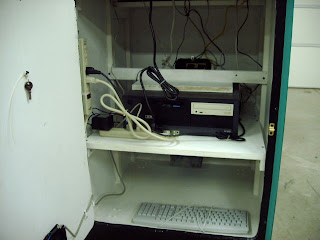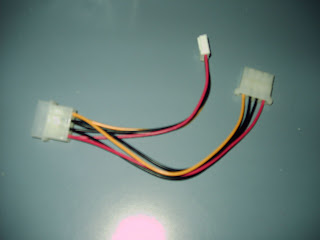Got the T-Molding installed. Here is a pic of the top part of the monitor and the marquee..
(Marquee is not powered up.)

Here is a blurred picture of the monitor. You can see the speakers in this picture. I used regular computer speakers, hacked from a cheap set. The covers are car speaker covers. They add a good look to it, I think.
I have yet to install the black bezel and plexi glass over the monitor.

Here is a picture of the speakers. Can you see the volume knob between the speakers?
The speakers are mounted in the holes I showed you earlier, held in place by 4 screws each. The covers have snap out grills. The frame of the cover is held with 4 screws. When you snap the covers on, you cant see the screws.

And here is a shot from behind the marquee. You can see the speakers, the speaker amp, and the volume control pot, which is held in place by the block of wood. I removed the pot from the amplifier board, and soldered extension wires between it and the board.
You can also see the 12 volt incandescent marquee lamps.

We decided to remove the coin door and paint it. I think it looks a lot better now.
Locks are installed now too.

And here are the coin mechs, switches are not yet wired.

And here are the coin switches wired in.
We installed a small L shaped bracket across the two coin mechs. We mounted a toggle switch to it.
This switch can be used to enable or disable the coin cheat switches.
The switch will be behind the coin door, only accessible if door is opened, requiring a key to open. The yellow cable is a 4 conductor 22 AWG cable.
The coin slot lamps are not yet wired. They will be wired to the 12 volt power supply.

Here is the cable going to the bottom of the control panel cavity. It is attached to a terminal strip and wired into the coin cheat switches. I decided to use terminal strips so that the control panel can be completely removed, if ever need to. I used staples to fasten the cable up out of the way.

Here is a shot of the coin cheat buttons, wired into the terminal strip. (Terminal strip is on the left, hard to see in this pic.) The other terminal strip is for the trackball light. it will have 12 volts wired to it. (Sooner or later.)

Next is a shot of one of the monitor braces. We put a small block on each side of the monitor, to keep it from moving sideways.
The front of the monitor sticks through a hole cut in the monitor panel. It fits snug.
The shelf the monitor is sitting on has a brace beneath it, to keep the shelf from bowing under the weight of the monitor. I removed the tilt and swivel thing that the monitor ordinarily sits on. We didnt need it on this project. It was easily removed.

Next is the top brace. It goes across the top of the monitor, and wedges against the flared out part of it. This keeps the monitor from sliding back away from the monitor panel.
There are also two L brackets on the very top of the monitor. I attached them to the monitor using screws in existing air vent holes. I made sure nothing was inside that the screws could touch.
The L brackets keep the monitor from sliding towards the front of the arcade.
I wont touch a lot on how I mounted the monitor. Each monitor is different. it may be shaped different, or be a different size. Just think about how you are going to mount your monitor, and make sure it is held securely in place. And remember, most monitors are heavy, so support the shelving so that it will hold the weight for a long time. Remember also that the monitor needs to "breathe" so allow air space around it and try not to cover too many air vent holes.

Here is the front bottom part of the monitor. I cut out the monitor panel to allow access to the controls. These will be covered up with the monitor bezel, but if the monitor should ever need adjusting, it shouldnt be a big deal to remove the bezel to get to these controls.
The bottom part of the monitor had a recessed area under the controls, this worked out good, it keeps the monitor from sliding forward on the bottom.
The power button was in this recessed area, so i bored a hole to allow me to insert a pen to turn it on, if I need to. (I will have to plug the monitor up and make sure it is turned on before installing the bezel.) The monitor switch we be on all the time.

There will be a space between the upper-back panel and the back-top panel. This is to allow heat to exit the cabinet.
We used nylon screen wire to keep dust and bugs out. When we first installed it, it sagged in the middle, so we had to install two braces for it to staple to.
When both panels are installed, there will be about a 2 inch wide opening across the width of the machine. This screen will be behind the panels and across the opening.
This opening should be sufficient to allow the hot air to escape. (The fan at the bottom of the cabinet will help a lot too.)

Now, I need to cut out the monitor bezel and monitor plexi glass.
The control panel is ready to mount, but since the edge of it will be in front of the monitor's plexi glass, that plexi glass will have to be installed first.
I am working on the computer, installing necessary software. It is just about ready.
I have also been working on the switched power strip. (More on that later).
So everything is really starting to come together now.
--------------------------

























































